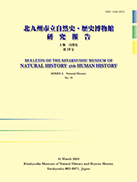Volume 9
Displaying 1-6 of 6 articles from this issue
- |<
- <
- 1
- >
- >|
Editorial
-
2011Volume 9 Pages 1-2
Published: March 31, 2011
Released on J-STAGE: May 03, 2021
Download PDF (607K)
Original Article
-
Article type: research-article
2011Volume 9 Pages 3-7
Published: March 31, 2011
Released on J-STAGE: May 03, 2021
Download PDF (1254K) -
Article type: research-article
2011Volume 9 Pages 9-106
Published: March 31, 2011
Released on J-STAGE: May 03, 2021
Download PDF (36507K) -
Article type: research-article
2011Volume 9 Pages 107-136
Published: March 31, 2011
Released on J-STAGE: May 05, 2021
Download PDF (21322K) -
Article type: research-article
2011Volume 9 Pages 137-155
Published: March 31, 2011
Released on J-STAGE: May 04, 2021
Download PDF (7639K) -
Article type: research-article
2011Volume 9 Pages 157-165
Published: March 31, 2011
Released on J-STAGE: May 03, 2021
Download PDF (1170K)
- |<
- <
- 1
- >
- >|
